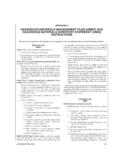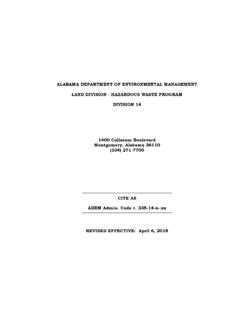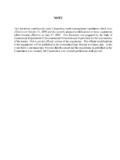Transcription of Appendix C—Transportation of Infectious Substances
1 336 Biosafety in Microbiological and Biomedical LaboratoriesAppendix C transportation of Infectious SubstancesAn Infectious substance is a material known to contain or reasonably expected to contain a pathogen. A pathogen is a microorganism (including bacteria, viruses, rickettsiae, parasites, fungi) or other agent, such as a proteinaceous Infectious particle (prion), that can cause disease in humans or animals. Infectious Substances may exist as purified and concentrated cultures, but may also be present in a variety of materials, such as body fluids or tissues. transportation of Infectious Substances and materials that are known or suspected to contain them are regulated as hazardous materials by the United State Department of transportation (DOT), foreign governments, and the International Civil Aviation Organization, and their transportation is subject to regulatory controls.
2 For transport purposes, the term Infectious substance is understood to include the term etiologic agent. transportation RegulationsInternational and domestic transport regulations for Infectious Substances are designed to prevent the release of these materials in transit to protect the public, workers, property, and the environment from the harmful effects that may occur from exposure to these materials. Protection is achieved through rigorous packaging requirements and hazard communication. Packages must be designed to withstand rough handling and other forces experienced in transportation , such as changes in air pressure and temperature, vibration, stacking, and moisture. Hazard communication includes shipping papers, labels, markings on the outside of packagings, and other information necessary to enable transport workers and emergency response personnel to correctly identify the material and respond efficiently in an emergency situation.
3 In addition, shippers and carriers must be trained on these regulations so they can properly prepare shipments and recognize and respond to the risks posed by these agents include Infectious Substances that have been identified by the CDC and the USDA as having the potential to pose a severe threat to public health and safety. Persons who offer for transportation or transport select agents in commerce in the United States must develop and implement security plans for such transportation . A security plan must include an assessment of the possible transportation security risks for materials covered by the security plan and specific measures to reduce or eliminate the assessed risks. At a minimum, a security plan must include measures to address those risks associated with personnel security, en route security, and unauthorized of transportation .
4 49 CFR Part 171-180, Hazardous Materials Regulations. Applies to the shipment of Infectious Substances in commercial transportation within the United States. Information on these regulations is available at: Appendix C: transportation of Infectious Substances 337 United States Postal Service (USPS). 39 CFR Part 20, International Postal Service (International Mail Manual), and Part 111, General Information on Postal Service (Domestic Mail Manual). Regulations on transporting Infectious Substances through the USPS are codified in Section of the Domestic Mail Manual and Section 135 of the International Mail Manual. A copy of the Domestic and International Mail Manuals may be obtained from the Government Printing Office by calling Monday through Friday, 7:30 9:00 EST: (202) 512-1800; toll free (866) 512-1800; or at the USPS Web site: Health and Safety Administration (OSHA).
5 29 CFR Part , Occupational Exposure to Bloodborne Pathogens. These regulations provide minimal packaging and labeling for blood and body fluids when transported within a laboratory or outside of it. Information may be obtained from your local OSHA office or at the OSHA Web site: Instructions for the Safe Transport of Dangerous Goods by Air (Technical Instructions). International Civil Aviation Organization (ICAO). Applies to the shipment of Infectious Substances by air and is recognized in the United States and by most countries worldwide. A copy of these regulations may be obtained from the ICAO Document Sales Unit at (514) 954-8022, fax: (514) 954-6769; e-mail: or from the ICAO Web site: Goods Regulations. International Air Transport Association (IATA). These regulations are issued by an airline association, are based on the ICAO Technical Instructions, and are followed by most airline carriers.
6 A copy of these regulations is available at: or ; or by contacting the IATA Customer Care office at: telephone: +1 (514) 390 6726; fax: +1 (514) 874 9659; for Canada and USA (800) 716-6326 (toll free); Europe, Africa and Middle East +41 (22) 770 2751; fax: +41 (22) 770 2674; TTY: YMQTPXB, or e-mail: governing the transfer of biological agents are designed to ensure that possession of these agents is in the best interest of the public and the nation. These regulations require documentation of personnel, facilities, justification of need and pre-approval of the transfer by a federal authority. The following regulations apply to this category:Importation of Etiologic Agents of Human Disease. 42 CFR Part 71 Foreign Quarantine. Part Etiological Agents, Hosts and Vectors. This regulation requires an import permit from the CDC for importation of etiologic agents, hosts or vectors of human disease.
7 The regulation, application form, and additional guidance is available at the CDC Web site: 338 Biosafety in Microbiological and Biomedical LaboratoriesCompleted application forms may be submitted to the CDC Etiologic Agent Import Permit Program by fax: (404) 718-2093, or by mail:Centers for Disease Control and Prevention Etiologic Agent Import Permit Program 1600 Clifton Road, , Mailstop A-46 Atlanta, GA 30333 Importation of select agents or toxins into the also requires the intended recipient to be registered with the Select Agent Program and submit an APHIS/ CDC Form 2 to obtain approval to import the select agent or toxin prior to each importation event (see 42 CFR 73 and/or 9 CFR 121). More information regarding select agents and toxins is available at: of Etiologic Agents of Livestock, Poultry and Other Animal Diseases and Other Materials Derived from Livestock, Poultry or Other Animal.
8 9 CFR Parts 122. Organisms and Vectors. The USDA, APHIS, Veterinary Services (VS) requires that a permit be issued prior to the importation or domestic transfer (interstate movement) of etiologic disease agents of livestock, poultry, other animals. Information may be obtained at (301) 734-5960, or from the USDA Web site: Completed permit applications may be submitted electronically at: ; or by fax to (301) 734-3652; or by mail to:USDA APHIS VS National Center for Import and Export 4700 River Road Unit 2, Mailstop 22, Cubicle 1A07 Riverdale, MD 20737 Importation of select agents into the United States also requires the intended recipient to be registered with the Select Agent Program and submit an APHIS/ CDC Form 2 to obtain approval to import the select agent or toxin prior to each importation event (see 42 CFR 73 and/or 9 CFR 121). More information regarding select agents and toxins is available at: of Plant Pests 7 CFR Part 330.
9 Federal Plant Pest Regulations; General; Plant Pests; Soil; Stone and Quarry Products; Garbage. This regulation requires a permit for movement into or through the United States, or interstate any plant pest or a regulated product, article, or means of conveyance in accordance with this part. Information can be obtained by calling (877) 770-5990 or at the USDA Web site: of Etiologic Agents of Humans, Animals, Plants and Related Materials; Department of Commerce (DoC); 5 CFR Parts 730 to 799. This regulation requires that exporters of a wide variety of etiologic agents of human, plant and animal Appendix C: transportation of Infectious Substances 339diseases, including genetic material, and products which might be used for culture of large amounts of agents, will require an export license. Information may be obtained by calling the DoC Bureau of Export Administration at (202) 482-4811, or at the DoC Web site: ; or at ; and of CDC Select Agents and Toxins.
10 42 CFR Part 73 Possession, Use, and Transfer of Select Agents and Toxins. The CDC regulates the possession, use, and transfer of select agents and toxins that have the potential to pose a severe threat to public health and safety. The CDC Select Agent Program registers all laboratories and other entities in the United States that possess, use, or transfer a select agent or toxin. Entities transferring or receiving select agents and toxins must be registered with the Select Agent Program and submit an APHIS/CDC Form 2 (see 42 CFR 73 and/or 9 CFR 121) to obtain approval prior to transfer of a select agent or toxin. The regulations, Select Agent Program forms, and additional guidance is available at the CDC Web site: of USDA Select Agents and Toxins. 9 CFR Part 121 Possession, Use, and Transfer of Select Agents and Toxins. The USDA, APHIS, VS regulates the possession, use, and transfer of select agents and toxins that have the potential to pose a severe threat to animal health or animal products.

















